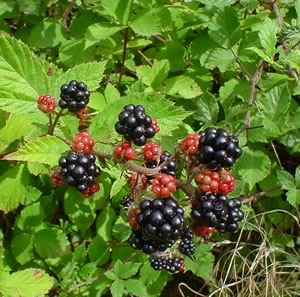
Rubus is a large and diverse genus of flowering plants in the rose family, Rosaceae, subfamily Rosoideae, with 250–700 species.

Rubus phoenicolasius is an Asian species of raspberry in the rose family, native to China, Japan, and Korea.

Rubus strigosus, the American red raspberry or American raspberry, is a species of Rubus native to much of North America. It has often been treated as a variety or subspecies of the closely related Eurasian Rubus idaeus, but currently is more commonly treated as a distinct species. Many of the commercial raspberry cultivars grown for their fruit derive from hybrids between R. strigosus and R. idaeus; see Raspberry for more details.

Rubus armeniacus, the Himalayan blackberry or Armenian blackberry, is a species of Rubus in the blackberry group Rubus subgenus Rubus series Discolores Focke. It is native to Armenia and Northern Iran, and widely naturalised elsewhere. Both its scientific name and origin have been the subject of much confusion, with much of the literature referring to it as either Rubus procerus or Rubus discolor, and often mistakenly citing its origin as western European. Flora of North America, published in 2014, considers the taxonomy unsettled, and tentatively uses the older name Rubus bifrons.

Rubus ursinus is a North American species of blackberry or dewberry, known by the common names California blackberry, California dewberry, Douglas berry, Pacific blackberry, Pacific dewberry and trailing blackberry.

Dalibarda repens(dewdrop, false violet, star violet, Robin runaway. French Canadian: dalibarde rampante) is a perennial plant in the rose family, native to eastern and central Canada and to the northeastern and north-central United States. It is the only species in the genus Dalibarda, which is closely allied with the genus Rubus. The species is often included in the genus Rubus as Rubus repens (L.) Kuntze. It is fairly easily grown in shady locations in damp to wet, acidic soils, and is frequently used in wildflower and bog gardens as a ground-cover.
Rubus aptatus, the drybank dewberry, is a rare North American species of flowering plant in the rose family. It is found in scattered locations in the northeastern United States.
Rubus bigelovianus, the lowland blackberry, is a North American species of flowering plant in the rose family. It is native to the States of Massachusetts, Rhode Island, Connecticut, and New York in the northeastern United States.

Rubus cuneifolius, the sand blackberry, is a North American species of flowering plant in the rose family. It occurs in the eastern United States in every coastal state from Louisiana to New Hampshire, with the exception of Rhode Island. There are also reports of inland populations in Tennessee, Arkansas, and Oklahoma, and the species has become naturalized in South Africa.
Rubus dissimilis, the bristly Oswego blackberry, is a rare North American species of flowering plant in the rose family. It grows in scattered locations in the northeastern and north-central United States. Nowhere is it very common.
Rubus fraternalis is an uncommon North American species of flowering plant in the rose family. It has been found in Québec and in the northeastern United States.
Rubus setosus, the bristly blackberry, is a North American species of flowering plant in the rose family. It is widespread in much of central and eastern Canada and the northeastern and north-central United States
Rubus parliniiis a rare North American species of flowering plant in the rose family. It is native to the northeastern United States.
Rubus rossbergianus is an uncommon North American species of flowering plant in the rose family. It grows in northeastern United States.
Rubus novanglicus is an uncommon North American species of flowering plant in the rose family. It grows in northeastern United States, having been found only in the State of Connecticut.
Rubus gnarus is a North American species of flowering plant in the rose family. It is native to the northeastern United States.
Rubus insons is a North American species of flowering plants in the rose family. It has been found only in the States of New York, Connecticut, Massachusetts, Vermont, and New Hampshire in the northeastern United States.
Rubus insulanus is a North American species of flowering plants in the rose family. It has been found only in the States of Rhode Island, Connecticut, and New York in the northeastern United States.
Rubus obsessus is a rare North American species of flowering plants in the rose family. It is found only in the States of New York and Connecticut in the northeastern United States.
Rubus particeps is rare North American species of brambles in the rose family. It has been found only in the State of Connecticut in the northeastern United States, and the Province of Nova Scotia in eastern Canada.






